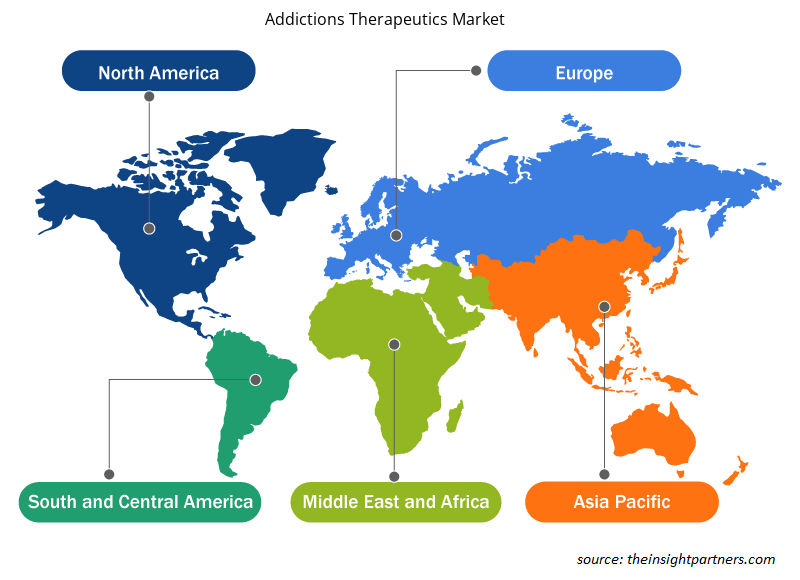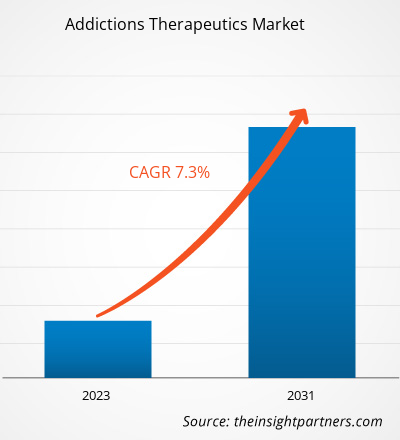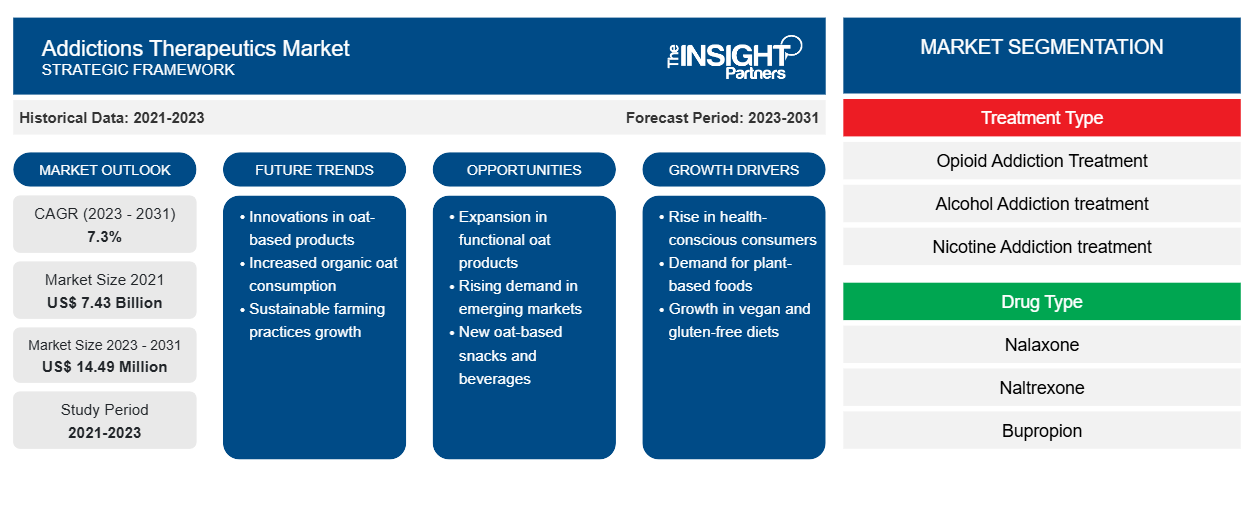Se estimó que el tamaño del mercado de terapias para adicciones sería de US$ 7.43 mil millones en 2021 y US$ XX millones en 2023 y se espera que alcance los US$ 14.49 millones para 2031; se estima que registrará una CAGR de 7.3% hasta 2031. Es probable que el lanzamiento constante de varias terapias siga siendo una tendencia clave del mercado de terapias para adicciones .
Análisis del mercado de la terapia contra las adicciones
Los líderes, los poderes gubernamentales y las organizaciones no gubernamentales (ONG) están buscando nuevas formas de crear conciencia y combatir la epidemia de la creciente adicción a las sustancias. Por ejemplo, el Consejo sobre Abuso de Sustancias Químicas participa en varias campañas estatales y nacionales para generar conciencia sobre el abuso de sustancias, la recuperación y la prevención.
La Oficina de las Naciones Unidas contra la Droga y el Delito (ONUDD) lleva adelante una campaña mundial para crear conciencia sobre el gran desafío que representan las drogas ilícitas para la sociedad y la población joven. La ONUDC lleva a cabo diversas actividades de sensibilización en todo el mundo e invita a particulares, al sector privado, a organizaciones sin fines de lucro y a los Estados miembros a organizar programas de divulgación institucional contra el tráfico ilícito y el abuso de drogas.
Además, en agosto de 2023, se lanzó una campaña en la India para desalentar el vapeo entre los adolescentes. La campaña tenía como objetivo recomendar soluciones efectivas y buscar la ayuda de expertos para crear una comunicación impactante que resaltara los efectos adversos del vapeo. Además, la campaña tenía como objetivo crear conciencia sobre la prohibición del vapeo en la India y otros países, explicando las razones detrás de tales medidas.
Es probable que campañas de concientización similares y esfuerzos gubernamentales para contrarrestar el abuso de drogas y promover medicamentos para eliminar todo tipo de adicciones impulsen el crecimiento del mercado durante el período de pronóstico.
Panorama del mercado de la terapia contra las adicciones
El mercado mundial de terapias para las adicciones está segmentado por región en América del Norte, Europa, Asia Pacífico, Oriente Medio y África, y América del Sur y Central. La región de América del Norte tiene la mayor participación de mercado, mientras que la región de Asia Pacífico es la región de más rápido crecimiento. El crecimiento del mercado en América del Norte se debe principalmente a la entrada de nuevos actores del mercado, varios lanzamientos de productos y el creciente número de personas que tienen una o más adicciones a sustancias. Además, Asia Pacífico es el mercado de terapias para las adicciones de más rápido crecimiento en un escenario global. China, India y Japón son tres de los principales contribuyentes al crecimiento del mercado, que está impulsado por la gran cantidad de consumo de narcóticos, el desarrollo masivo de medicamentos genéricos para el tratamiento de las adicciones, así como la aparición de actores locales en la región. Además, las inversiones en investigación y desarrollo (I+D) de las empresas farmacéuticas multinacionales también impulsan el crecimiento del mercado.
Personalice este informe según sus necesidades
Obtendrá personalización en cualquier informe, sin cargo, incluidas partes de este informe o análisis a nivel de país, paquete de datos de Excel, así como también grandes ofertas y descuentos para empresas emergentes y universidades.
-
Obtenga las principales tendencias clave del mercado de este informe.Esta muestra GRATUITA incluirá análisis de datos, desde tendencias del mercado hasta estimaciones y pronósticos.
Factores impulsores y oportunidades del mercado de la terapia contra las adicciones
Fomentar las alianzas entre organizaciones para favorecer el mercado
Existen varias organizaciones en el mercado de terapias para adicciones que se han asociado para impulsar el crecimiento del mercado. Por ejemplo, en septiembre de 2023, Click Therapeutics colaboró con Indivior. La colaboración tiene como objetivo desarrollar y comercializar terapias digitales con receta para tratar los trastornos por consumo de sustancias, comenzando por el trastorno por consumo de opioides (OUD). La colaboración se facilitará a través de una aplicación móvil llamada CT-102, que tiene como objetivo abordar las principales brechas en el OUD, como el acceso a un tratamiento psicosocial personalizado y de alta calidad.
De manera similar, en enero de 2023, Pear Therapeutics amplió su asociación con clínicas ambulatorias de tratamiento de adicciones. Spero Health ahora puede utilizar las terapias digitales de prescripción reSET y reSET-O de Pear en 99 ubicaciones en cinco estados, después de usarlas anteriormente en solo 14 clínicas en Kentucky. Por lo tanto, las crecientes asociaciones entre organizaciones impulsan el crecimiento del mercado de terapias para adicciones.
La creciente demanda de I+D por parte de las organizaciones subcontratadas: una oportunidad
En los últimos años, la industria farmacéutica ha experimentado un rápido crecimiento de los servicios de externalización, impulsado por muchos factores, como el aumento de la demanda de analgésicos, el aumento de la complejidad de los principios activos y la creciente necesidad de reducir los costes de desarrollo. Las grandes empresas farmacéuticas están externalizando las actividades de I+D para aumentar la velocidad del proceso de desarrollo de fármacos y reducir sus costes de desarrollo y fabricación.
Varias empresas farmacéuticas, incluida la que fabrica terapias para la adicción, dependen de organizaciones de investigación por contrato (CRO) para minimizar los altos costos fijos del desarrollo interno, las capacidades de fabricación y la experiencia. La creciente complejidad en el desarrollo de nuevas entidades moleculares (NME) ha creado una necesidad de capacidades de nicho que las empresas farmacéuticas prefieren externalizar en lugar de hacerlo internamente. Con el aumento de las aprobaciones de medicamentos (la FDA aprobó 55 NME en 2023), hay un aumento en el desarrollo clínico sólido y la demanda de externalización. Varias empresas de biotecnología están aprovechando las CRO para expandir su cartera de posibles candidatos a medicamentos. Es probable que la reducción de los costos de fabricación de medicamentos a través de la externalización ofrezca importantes oportunidades de crecimiento a los actores del mercado con el fin de maximizar los márgenes de ganancia y mantenerse en el dinámico mercado de terapias para la adicción.
Análisis de segmentación del informe de mercado de terapias para adicciones
Los segmentos clave que contribuyeron a la derivación del análisis del mercado de terapias para adicciones son el tipo de tratamiento, el tipo de fármaco, el centro de tratamiento y el canal de distribución.
- Según el tipo de tratamiento, el mercado de terapias para adicciones se segmenta en tratamiento de adicción a la nicotina, tratamiento de adicción al alcohol, tratamiento de adicción a los opioides y tratamiento de adicción a otras sustancias. El segmento de tratamiento de adicción a la nicotina tuvo la mayor participación de mercado en 2023.
- Por tipo de fármaco, el mercado está segmentado en vareniclina, bupropión, productos de reemplazo de nicotina, buprenorfina, naltrexona, disulfiram y otros. El segmento de vareniclina tuvo la mayor participación del mercado en 2023.
- En términos de centros de tratamiento, el mercado está segmentado en centros de tratamiento ambulatorio, centros de tratamiento residencial y centros de tratamiento para pacientes hospitalizados. El segmento de centros de tratamiento ambulatorio dominó el mercado en 2023.
Análisis de la cuota de mercado de los tratamientos para las adicciones por geografía
El alcance geográfico del informe de mercado de terapias para adicciones se divide principalmente en cinco regiones: América del Norte, Asia Pacífico, Europa, Medio Oriente y África, y América del Sur/América del Sur y Central.
América del Norte es el mayor mercado de terapias para las adicciones, y Estados Unidos tiene la mayor participación de mercado, seguido de Canadá. El crecimiento en América del Norte se caracteriza por la entrada de nuevos actores en el mercado, varios lanzamientos de productos y un creciente número de personas con una o más adicciones a sustancias. Los actores del mercado en Estados Unidos recaudan fondos para el tratamiento de las adicciones. Por ejemplo, en julio de 2023, Affect Therapeutics, una empresa que está revolucionando el tratamiento de las adicciones mediante tecnología digital, anunció que había recaudado 16 millones de dólares en una ronda de financiación de Serie A liderada por ARTIS Ventures, una empresa de inversión centrada en la biotecnología. Los fondos recaudados se utilizarán para ampliar los programas de la empresa a nivel nacional, así como para mejorar la aplicación Affect mediante la innovación en ingeniería.
Perspectivas regionales del mercado de terapias para adicciones
Los analistas de Insight Partners explicaron en detalle las tendencias y los factores regionales que influyen en el mercado de terapias para las adicciones durante el período de pronóstico. Esta sección también analiza los segmentos y la geografía del mercado de terapias para las adicciones en América del Norte, Europa, Asia Pacífico, Oriente Medio y África, y América del Sur y Central.

- Obtenga datos regionales específicos para el mercado de terapias contra las adicciones
Alcance del informe sobre el mercado de terapias para las adicciones
| Atributo del informe | Detalles |
|---|---|
| Tamaño del mercado en 2021 | US$ 7,43 mil millones |
| Tamaño del mercado en 2031 | US$ 14,49 millones |
| CAGR global (2023 - 2031) | 7,3% |
| Datos históricos | 2021-2023 |
| Período de pronóstico | 2023-2031 |
| Segmentos cubiertos |
Por tipo de tratamiento
|
| Regiones y países cubiertos |
América del norte
|
| Líderes del mercado y perfiles de empresas clave |
|
Densidad de actores del mercado de terapias para adicciones: comprensión de su impacto en la dinámica empresarial
El mercado de productos terapéuticos para las adicciones está creciendo rápidamente, impulsado por la creciente demanda de los usuarios finales debido a factores como la evolución de las preferencias de los consumidores, los avances tecnológicos y una mayor conciencia de los beneficios del producto. A medida que aumenta la demanda, las empresas amplían sus ofertas, innovan para satisfacer las necesidades de los consumidores y aprovechan las tendencias emergentes, lo que impulsa aún más el crecimiento del mercado.
La densidad de actores del mercado se refiere a la distribución de las empresas o firmas que operan dentro de un mercado o industria en particular. Indica cuántos competidores (actores del mercado) están presentes en un espacio de mercado determinado en relación con su tamaño o valor total de mercado.
Las principales empresas que operan en el mercado de terapias para adicciones son:
- PLC individual
- Pfizer, Inc.
- GlaxoSmithKline S.A.
- Empresas de salud de Bausch
- Compañía Cipla, Inc.
- Orexo AB
Descargo de responsabilidad : Las empresas enumeradas anteriormente no están clasificadas en ningún orden particular.

- Obtenga una descripción general de los principales actores clave del mercado de Terapéutica de Adicciones
Noticias y desarrollos recientes del mercado de terapias para adicciones
El mercado de terapias para las adicciones se evalúa mediante la recopilación de datos cualitativos y cuantitativos a partir de investigaciones primarias y secundarias, que incluyen publicaciones corporativas importantes, datos de asociaciones y bases de datos. A continuación, se incluye una lista de los avances en el mercado de terapias para las adicciones:
- En enero de 2023, Hikma Pharmaceuticals PLC lanzó la inyección de clorhidrato de naloxona, USP, 2 mg/2 ml, en forma de jeringa precargada (PFS). Este medicamento se utiliza para el tratamiento de emergencia de una sobredosis de opioides conocida o sospechada y es el tercer producto PFS lanzado. La inyección está actualmente disponible en los EE. UU. (Fuente: Hikma Pharmaceuticals PLC, 2023)
- En enero de 2022, Pfizer se asoció con la start-up sueca Alex Therapeutics para aventurarse en el espacio de la terapia digital. La plataforma basada en IA de Alex Therapeutics integra tanto la terapia cognitivo-conductual (TCC) como la terapia de aceptación y compromiso (ACT) con IA para personalizar la atención. El objetivo inicial de su asociación es crear terapias digitales para el tratamiento de la adicción a la nicotina y comenzarán sus esfuerzos en el mercado alemán. (Fuente: Pfizer, 2022)
Informe sobre el mercado de terapias para adicciones: cobertura y resultados
El informe “Tamaño y pronóstico del mercado de terapias para adicciones (2022-2030)” proporciona un análisis detallado del mercado que cubre las siguientes áreas:
- Tamaño del mercado y pronóstico a nivel global, regional y nacional para todos los segmentos clave del mercado cubiertos bajo el alcance
- Dinámica del mercado, como impulsores, restricciones y oportunidades clave
- Principales tendencias futuras
- Análisis detallado de las cinco fuerzas de Porter y PEST y FODA
- Análisis del mercado global y regional que cubre las tendencias clave del mercado, los principales actores, las regulaciones y los desarrollos recientes del mercado.
- Análisis del panorama de la industria y de la competencia que abarca la concentración del mercado, el análisis de mapas de calor, los actores destacados y los desarrollos recientes
- Perfiles detallados de empresas
- Análisis histórico (2 años), año base, pronóstico (7 años) con CAGR
- Análisis PEST y FODA
- Tamaño del mercado, valor/volumen: global, regional y nacional
- Industria y panorama competitivo
- Conjunto de datos de Excel
Informes recientes
Testimonios
Razón para comprar
- Toma de decisiones informada
- Comprensión de la dinámica del mercado
- Análisis competitivo
- Información sobre clientes
- Pronósticos del mercado
- Mitigación de riesgos
- Planificación estratégica
- Justificación de la inversión
- Identificación de mercados emergentes
- Mejora de las estrategias de marketing
- Impulso de la eficiencia operativa
- Alineación con las tendencias regulatorias























 Obtenga una muestra gratuita para - Mercado de Terapéutica de Adicciones
Obtenga una muestra gratuita para - Mercado de Terapéutica de Adicciones